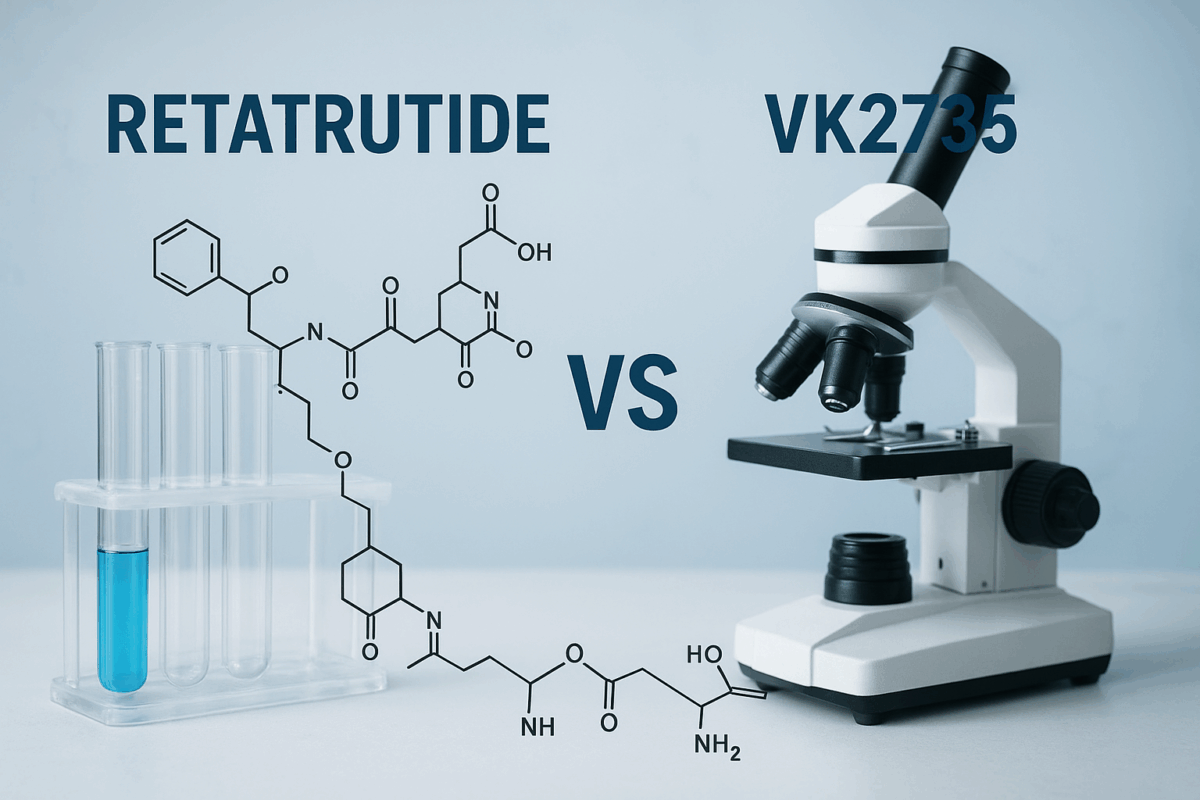Information
VK2735 vs Retatrutide: Eli Lilly’s Biggest Competitor
After an analysis of the current GLP-1 RA research landscape, it’s quite clear that retatrutide’s biggest competition is VK2735. However, it’s fair to say that VK2735 is about equal to retatrutide, and for various reasons, I expect retatrutide to dominate the GLP-1 RA market for quite a few years.
A quick primer
Although there was initial hope that NA-931 (marketed as Bioglutide) could be better than retatrutide (the current best-in-slot GLP-1 RA), my research into the company uncovered that Bioglutide doesn’t exist and it’s all one big scam. Imitation is the sincerest form of flattery, and there’s a good reason Biomed Industries heavily plagiarized the trial structure and resultant data from VK2735: it’s some of the best we’ve seen from a weight loss drug. Retatrutide was discovered by Eli Lilly, and they’ll have exclusive selling rights in most countries for quite some time: I love that for them, because retatrutide is better than tirzepatide (Mounjaro and Zepbound), and tirzepatide is already great. Retatrutide is likely to be available in Australia at the beginning of 2029 and as a medicine, the data suggests it’s fantastic. Because the market for GLP-1 RAs is so big (and growing rapidly), investors and potential utilizers are always curious about the next big thing.
Right now, nothing announced looks like it’s going to be strictly better than retatrutide, but if anything can give it a run for its money, VK2735 seems to be on equal footing, with a few caveats.
Head to head comparison
Alright, so let’s get into the numbers with the data that we do have. There are some nuances here: those will be addressed further down.
The best data we have for retatrutide shows around a 12% reduction in body weight after 12 weeks at an 8mg dose (initial dose: 4mg). VK2735’s data from this October 2025 corporate presentation shows a 14.7% reduction in body weight after 13 weeks (multi-tiered titration). Granular data isn’t available (at least to me) for placebo rates at the 12-week mark for retatrutide, but VK2735’s number is adjusted to 13.1%, since they do provide theirs in the presentation. Jumping through hoops for raw data from Eli Lilly is a pain: I did the next best thing and used Paint.net to estimate where the 12-week placebo line sat at, and for retatrutide, it’s about 0.9%.
So, cutting a long story short, retatrutide managed a 11.1% reduction in body weight after 12 weeks and VK2735 managed 13.1% after 13 weeks.
The caveats
There aren’t too many notable differences between the design of both studies, but titration schedules do matter and as a result, the dropout rates. Since we’re comparing specific dosages within both studies against one another, there are only a few dozen people involved in each – people tend to believe you need more participants than you actually do to make good inferences, but the two groups above are both N=35: it’s very difficult to draw too many conclusions as-is, but especially with regard to tolerability. With the numbers we do have, they both seem to be about the same, but since the retatrutide data comes from a much longer trial (and an increased likelihood of adverse events occurring), I’d give a slight edge to it in that respect.
BMIs were similar, but retatrutide had slightly heavier participants – though this is likely offset by the fact that VK2735’s study had a lot more women participating. Reta was basically 50/50 men and women, but VK’s was closer to 75/25. Women tend to lose more weight in GLP-1 RA studies: I have zero trust in my ability to adequately adjust for these factors, or the utility of such information in this specific case. While VK2735 has slightly better results on paper, spitball adjustment based on the gender ratios, and turning VK’s 13-week data into 12-week data, puts them on par with one another.
The last thing I want to mention is reporting bias: VK2735’s data has been filtered through corporate presentations, but there’s no publication in a respected journal yet. This really does matter for a number of reasons, especially since retatrutide’s phase 2 study was peer reviewed and published in The New England Journal of Medicine: this is about as good as it gets for study veracity and trustworthiness. Ania Jastreboff was the lead author too, who was also the lead author for tirzepatide’s big phase 3 study. We know that retatrutide exists (I even have retatrutide for sale) and that it works. I cannot say the same for VK2735.
Conclusion
If we give Viking Therapeutics’ data the benefit of the doubt, we’re looking at a drug that’s essentially on par with retatrutide. That said, Viking Therapeutics is a tiny company in comparison to Eli Lilly: the former currently has a market cap of 3.77 billion (NASDAQ: VKTX) whereas Lilly’s is 760 billion (NYSE: LLY). Is Viking Therapeutics even close to being in a position to spin up mass production of VK2735? Are they hoping to be bought out by the likes of Pfizer or another large pharmaceutical company that doesn’t have a viable GLP-1? Given the Bioglutide scam, I’m probably more risk-averse than usual, but Lilly and retatrutide still look like the safest bet to dominate the weight-loss drug market over the next decade.
I do hope that VK2735 is real and the data is solid, though. Competition lowers prices, and GLP-1 RAs aren’t cheap. Eli Lilly dethroned Novo Nordisk within a few years of semaglutide entering the picture, and it’s not impossible for a better alternative to retatrutide to emerge – even if it is just priced better.
Bottom line: VK2735 is the closest candidate to retatrutide and they’re about equal, but the data we have is less robust and the company behind it might struggle with synthesis and distribution.
For the foreseeable future, retatrutide is best in slot.

